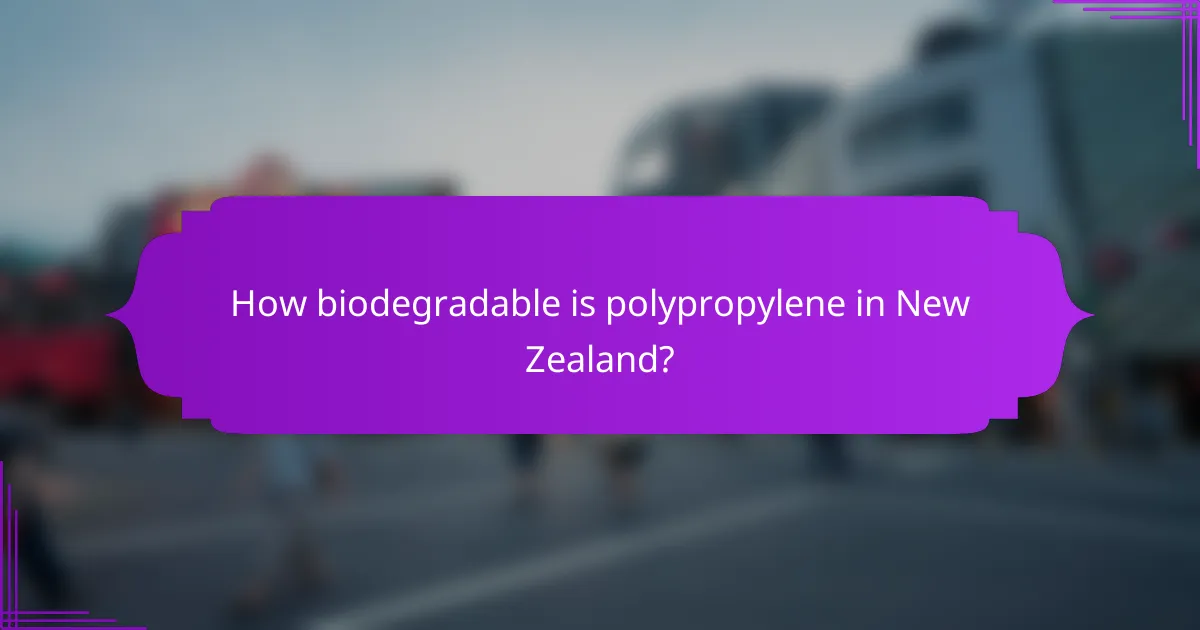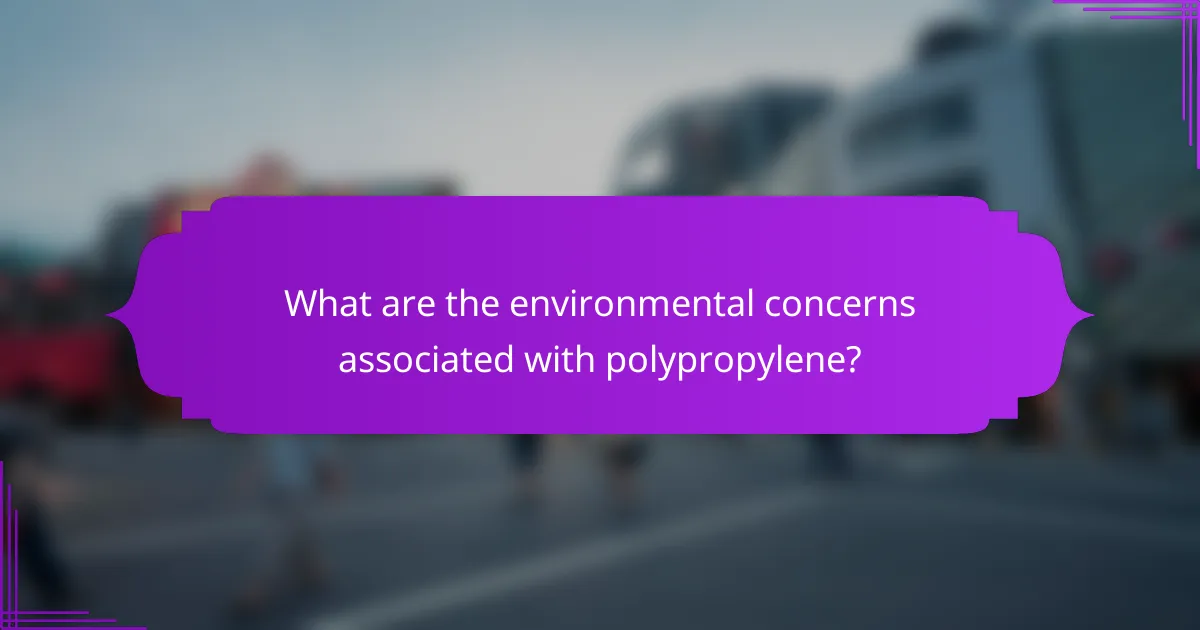Polypropylene is a widely used plastic known for its durability, but it poses significant environmental challenges due to its resistance to biodegradation, often taking hundreds of years to break down. In New Zealand, the accumulation of polypropylene waste raises concerns about pollution and ecosystem harm. However, recycling options are available, including curbside collection and drop-off centers, which aim to mitigate these issues by diverting polypropylene from landfills.

How biodegradable is polypropylene in New Zealand?
Polypropylene is not biodegradable in the traditional sense, as it can take hundreds of years to break down in the environment. In New Zealand, the lack of natural biodegradation means that polypropylene waste can accumulate, leading to significant environmental concerns.
Polypropylene biodegradation timeline
The biodegradation timeline for polypropylene is extensive, often exceeding 100 years under typical landfill conditions. In natural environments, the process can be even slower, as polypropylene is resistant to microbial action. This longevity poses challenges for waste management and environmental health.
Factors affecting biodegradability
Additionally, the chemical structure of polypropylene makes it less susceptible to breakdown compared to other organic materials. This resistance is a key reason why polypropylene is often not suitable for composting or other natural waste processing methods.
Comparative biodegradability with other plastics
When compared to other plastics, polypropylene’s biodegradability is notably poor. For instance, polylactic acid (PLA) can biodegrade within a few months under industrial composting conditions, while polyethylene terephthalate (PET) may take several decades. This stark contrast highlights the environmental impact of choosing polypropylene over more biodegradable alternatives.
In summary, while some plastics can break down relatively quickly, polypropylene remains a long-lasting pollutant, making its recycling and proper disposal critical for environmental sustainability in New Zealand.

What are the recycling options for polypropylene in New Zealand?
In New Zealand, polypropylene (PP) can be recycled through various local facilities that accept this type of plastic. Recycling options include curbside collection and drop-off centers, which help divert PP from landfills and promote sustainable practices.
Local recycling facilities
New Zealand has several local recycling facilities that accept polypropylene. Many councils provide curbside recycling services where residents can place PP items, such as containers and packaging, in designated bins. Additionally, some drop-off centers specifically cater to plastic recycling, making it easier for individuals to recycle their polypropylene waste.
Recycling process for polypropylene
The recycling process for polypropylene typically begins with the collection of PP materials from households and businesses. Once collected, the materials are sorted, cleaned, and processed into small pellets. These pellets can then be used to manufacture new products, such as automotive parts, containers, or textiles, effectively closing the recycling loop.
Challenges in polypropylene recycling
Despite the availability of recycling options, several challenges hinder polypropylene recycling in New Zealand. One major issue is contamination, as PP items often come mixed with other types of plastics or non-recyclable materials, complicating the sorting process. Additionally, the market demand for recycled polypropylene can fluctuate, impacting the viability of recycling programs.

What are the environmental concerns associated with polypropylene?
Polypropylene poses several environmental concerns, primarily due to its durability and resistance to biodegradation. This plastic can persist in the environment for many years, leading to pollution and harm to ecosystems.
Impact on marine life
Polypropylene waste often ends up in oceans and waterways, where it can be ingested by marine animals. This ingestion can lead to physical harm or even death for species such as fish, seabirds, and marine mammals. Additionally, microplastics from degraded polypropylene can accumulate in the food chain, potentially affecting human health.
Efforts to mitigate this impact include beach cleanups and stricter regulations on plastic waste disposal. Consumers can help by reducing single-use plastic consumption and supporting initiatives aimed at cleaning up marine environments.
Landfill contributions
Polypropylene is a significant contributor to landfill waste, as it is not widely recycled. Once in landfills, it can take decades to decompose, contributing to long-term environmental issues. The accumulation of polypropylene in landfills also increases the risk of leachate, which can contaminate soil and groundwater.
To combat this issue, individuals and businesses can prioritize recycling and choose products made from biodegradable materials. Participating in local recycling programs can also help reduce the amount of polypropylene that ends up in landfills.
Carbon footprint of polypropylene production
The production of polypropylene involves significant energy consumption, contributing to its carbon footprint. Manufacturing processes typically rely on fossil fuels, which release greenhouse gases into the atmosphere. This environmental impact raises concerns about climate change and the sustainability of plastic production.
To lessen this carbon footprint, manufacturers are exploring alternative production methods, such as using renewable energy sources. Consumers can also make a difference by opting for products made from recycled polypropylene or supporting companies that prioritize sustainable practices.

How does polypropylene compare to other plastics in terms of sustainability?
Polypropylene is generally considered more sustainable than many other plastics due to its recyclability and lower environmental impact during production. However, its biodegradability is limited, which raises concerns about long-term waste management.
Polypropylene vs. polyethylene
When comparing polypropylene to polyethylene, both are widely used plastics, but their sustainability profiles differ. Polypropylene has a higher melting point and is more resistant to chemical leaching, making it suitable for food packaging and medical applications.
In terms of recycling, both materials can be recycled, but polypropylene is often less frequently accepted in curbside recycling programs compared to polyethylene. This can lead to higher rates of polypropylene waste in landfills, despite its potential for reuse.
Polypropylene vs. polystyrene
Polypropylene and polystyrene differ significantly in their environmental impact. While polypropylene is recyclable and has a lower carbon footprint during production, polystyrene is often criticized for its environmental persistence and is not widely recycled.
Polystyrene is commonly used in disposable food containers and packaging, contributing to significant waste. In contrast, polypropylene’s versatility allows for more sustainable applications, such as reusable containers and automotive parts, which can reduce overall waste generation.

What are the future trends in polypropylene sustainability?
Future trends in polypropylene sustainability focus on enhancing biodegradability, improving recycling methods, and implementing supportive policies. These developments aim to reduce environmental concerns associated with polypropylene use and promote a circular economy.
Innovations in biodegradable polypropylene
Biodegradable polypropylene is being developed through the incorporation of additives that facilitate decomposition. These innovations allow polypropylene to break down more rapidly in natural environments, addressing the long-lasting impact of traditional plastics. Companies are exploring various formulations that can degrade within a few months to a couple of years, depending on environmental conditions.
One notable example is the use of starch-based additives, which can enhance the biodegradability of polypropylene products. This approach not only reduces waste but also maintains the material’s desirable properties, such as strength and flexibility.
Emerging recycling technologies
Advancements in recycling technologies are crucial for improving polypropylene’s sustainability. Mechanical recycling remains common, but new chemical recycling methods are gaining traction, allowing for the breakdown of polypropylene into its original monomers. This process can potentially enable infinite recycling cycles without degrading material quality.
Innovative sorting technologies, such as near-infrared spectroscopy, are also enhancing the efficiency of recycling facilities. These technologies can accurately identify and separate polypropylene from other plastics, increasing the overall recycling rates and reducing contamination.
Policy changes affecting polypropylene use
Policy changes are increasingly influencing the production and use of polypropylene. Many countries are implementing stricter regulations on plastic waste, encouraging manufacturers to adopt more sustainable practices. For instance, the European Union has set ambitious targets for reducing single-use plastics, which directly impacts polypropylene applications.
In addition, incentives for recycling and the development of biodegradable alternatives are becoming more common. Governments may offer subsidies or tax breaks to companies that invest in sustainable materials, fostering innovation in the polypropylene sector.

